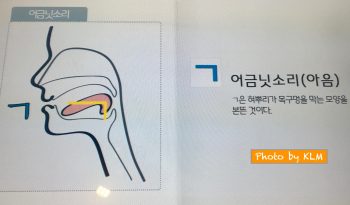The Scientific and Phonetic Korean Script, 한글(Hangeul): Consonants #2 Posted by Kyung-Hwa on Jul 26, 2017 in Grammar, Korean Language
Do you know why 한글 is considered a highly phonetic and scientific writing systems? You will have a good understanding after reading the following explanation of Korean consonants and their sounds.
Last week I introduced the brief history of 한글, and how to form syllables in Korean. This post will cover more detailed information about the 19 Korean consonants, including the creation process, names, and sounds.
The Korean consonant system can be categorized by the three following characteristics. This way you can easily understand the systemic characteristics of Korean consonants.
The Basic Consonants
Interestingly, the five basic letters, ㄱㄴㅁㅅㅇ, are shaped after the vocal organs that are used to articulate each sound.

- ㄱ : the shape of the tongue when it touches the velum in the back of the mouth
- ㄴ : the shape of the tongue when the tip of it touches the alveolar
- ㅁ : the shape of the mouth
- ㅅ : the shape of the teeth
- ㅇ : the shape of the throat
Structural Expansion from the Basic Consonants
The nine consonants, ㅋㄷㅌㅂㅍㅈㅊㅎㄹ, are based on the five basic consonants above. By adding additional strokes to ㄱㄴㅁㅅㅇ, the following letters were created.
- ㄱ → ㅋ
- ㄴ → ㄷ / ㅌ
- ㅁ → ㅂ / ㅍ
- ㅅ → ㅈ / ㅊ
- ㅇ → ㅎ
- ㄹ
Expansion of the sound: Tensed Sounds
The following are five more consonants that were created by putting the same letters together to produce hard sounds.
- ㄱ → ㄲ
- ㄷ → ㄸ
- ㅂ → ㅃ
- ㅅ → ㅆ
- ㅈ → ㅉ
Now try and learn the name and sound of each letter. However, it is important to note that the sounds of the Korean letters do not perfectly match with English sounds. I added the closest sound values in English to help your understanding. Please listen to the audio file in order to study the accurate sounds of each consonant.
| Consonants | Names | Sounds
in Korean |
Sounds
in English |
|
| 1 | ㄱ | 기역 (giyeok) | ㄱ | g |
| 2 | ㄴ | 니은 (nieun) | ㄴ | n |
| 3 | ㄷ | 디귿 (digeut) | ㄷ | d |
| 4 | ㄹ | 리을 (rieul) | ㄹ | l (between r and l) |
| 5 | ㅁ | 미음 (mieum) | ㅁ | m |
| 6 | ㅂ | 비읍 (bieup) | ㅂ | b |
| 7 | ㅅ | 시옷 (siot) | ㅅ | s |
| 8 | ㅇ | 이응 (ieung) | ㅇ | * no sound or -ng |
| 9 | ㅈ | 지읒 (jieut) | ㅈ | j |
| 10 | ㅊ | 치읓 (chieut) | ㅊ | ch |
| 11 | ㅋ | 키읔 (kieuk) | ㅋ | k |
| 12 | ㅌ | 티읕 (tieut) | ㅌ | t |
| 13 | ㅍ | 피읖 (pieub) | ㅍ | p |
| 14 | ㅎ | 히읗 (hieut) | ㅎ | h |
| 15 | ㄲ | 쌍기역 (ssang giyeok) | ㄲ | gg |
| 16 | ㄸ | 쌍디귿 (ssang digeut) | ㄸ | dd |
| 17 | ㅃ | 쌍비읍 (ssang bieup) | ㅃ | bb |
| 18 | ㅆ | 쌍시옷(ssang siot) | ㅆ | ss |
| 19 | ㅉ | 쌍지읒 (ssang jieut) | ㅉ | jj |
* Whenㅇ is the initial consonant of C (consonant) + V (vowel) combination, it acts as a silent place holder for the vowels.
ex) 아 (“a” as in “ah”) : ㅇ(no sound) + ㅏ(a)
* When ㅇ is in the final consonant place of C (consonant) + V (vowel) + C (consonant) combination, it takes an “-ng” sound.
ex) 방 (bang) : ㅂ (b) +ㅏ(a) + ㅇ (ng)
If you are interested in practicing each consonant and related vocabulary, please click the following link.
http://www.indiana.edu/~koreanrs/hangul.html
Aren’t you thankful to King Sejong who carefully formed the five basic consonants and produced the other consonants by adding different elements to the basic ones? I am truly amazed with his and his scholars’ linguistic knowledge back in the 1400s. I hope the above explanation and audio file will help you to become familiar with the Korean consonants.
감사합니다! (Thank you!)

Build vocabulary, practice pronunciation, and more with Transparent Language Online. Available anytime, anywhere, on any device.



